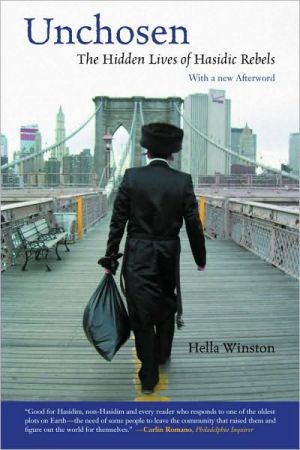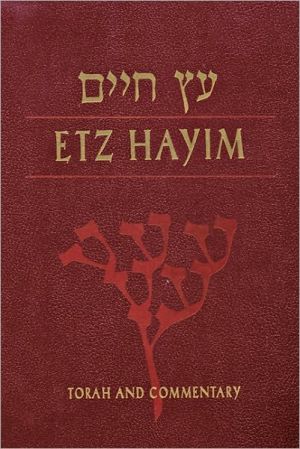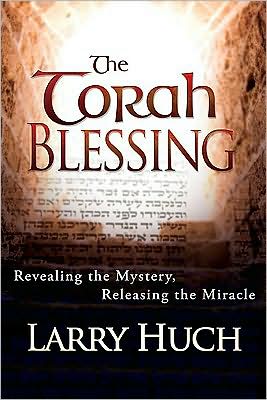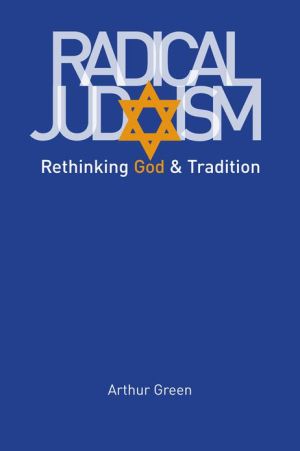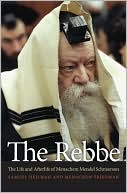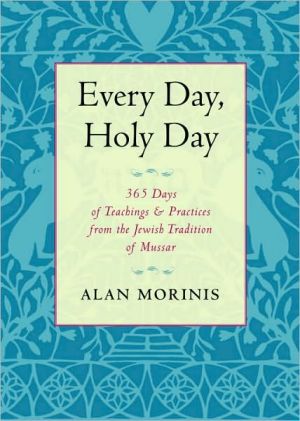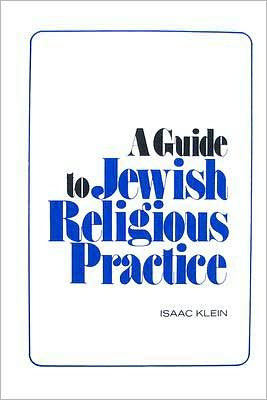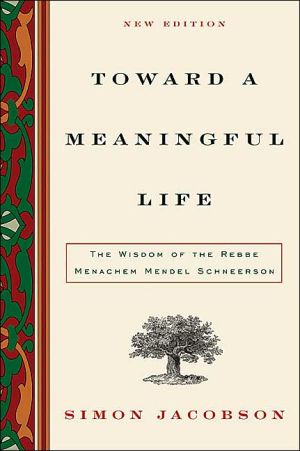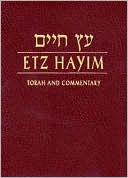Unchosen: The Hidden Lives of Hasidic Rebels
When Hella Winston began talking with Hasidic Jews for her doctoral dissertation in sociology, she was excited to be meeting with members of the highly insular Brooklyn Satmar sect. Several Jewish journalists and scholars have produced admiring books describing the Lubavitch way of life and the group’s outreach efforts, but very little has been written about the other Hasidic sects, despite their combined greater numbers. Unlike Lubavitch, members of these other groups do not engage in...
Search in google:
When Hella Winston began talking with Hasidic Jews for her doctoral dissertation in sociology, she was excited to be meeting with members of the highly insular Brooklyn Satmar sect. Several Jewish journalists and scholars have produced admiring books describing the Lubavitch way of life and the group s outreach efforts, but very little has been written about the other Hasidic sects, despite their combined greater numbers. Unlike Lubavitch, members of these other groups do not engage in outreach and are raised to avoid all unnecessary contact with outside society. Winston s access was unprecedented. She never could have guessed what would happen next--that she would be introduced, slowly and covertly, to Hasidim deeply unhappy with their highly restrictive way of life and sometimes desperately struggling to leave their communities. First there was Yossi, a young man yearning to leave but, like most male Hasidim, a Yiddish speaker with only fourth grade English and math skills. Then she met Dini, a wife and mother called before the all-male modesty patrol because someone had spotted her outside a bar in a T-shirt and miniskirt. There were others still who had actually left. Unchosen tells the story of these and other "rebel" Hasidim, serious questioners who long for greater personal and intellectual freedom than their communities allow. In so doing, Unchosen forces us to reexamine the history of these communities and asks us to consider what we choose not to see when we romanticize them. Publishers Weekly While other excellent studies by Sue Fishkoff, Stephanie Wellen-Levine and Lis Harris have examined the inner lives of Lubavitcher Hasidim in a mostly positive way, this account distinguishes itself by focusing on the "rebels," not just among the Lubavitch but in other Hasidic communities as well, including the insular and right-wing Satmar sect. Winston, a doctoral candidate in sociology at CUNY, unfolds a world-within-a-world, where some young Hasidim sneak televisions into their apartments in garbage bags, change clothes on the subway to frequent bars in Manhattan and blog about their double lives online. She builds fascinating case studies, inviting readers into her interviewees' conflicted, and often painful, lives. One chapter profiles a famous Hasidic teacher who in fact no longer believes; another offers a walking tour of a Hasidic 'chood (slang for neighborhood); and another chronicles the hopeful and inspiring story of Malkie, a college-age woman who is building a sort of halfway house for others, like her, who have chosen to leave Hasidism. Winston shows us a Hasidic underworld where large families and a lack of secular education have resulted in extreme poverty and some serious at-risk behavior among youth. Her story of courage and intellectual rebellion will inspire anyone who has ever felt like a religious outcast. (Nov.) Copyright 2005 Reed Business Information.
\ \ Unchosen\ \ \ The Hidden Lives of Hasidic Rebels\ \ \ \ By Hella Winston\ \ \ Beacon Press\ \ \ Copyright © 2005\ \ Hella Winston\ All right reserved.\ \ ISBN: 0-8070-3626-9\ \ \ \ \ \ \ Chapter One\ \ \ Changing Trains \ When he heard what Yossi wanted, the barber appeared stunned\ at first, and then relaxed into laughter, assuming it must be some kind\ of joke. Yossi's left leg began to twitch as he shifted uncomfortably\ in the sticky leather chair. Hours earlier, he had made the decision\ to shave off his beard and get rid of his peyos for good, and if\ this man wasn't going to help him do it, he would find someone else\ who would. His whole family, except for his sixteen-year-old sister,\ Chayla, had just left to spend the rest of the summer at a bungalow\ colony in the mountains. If Yossi was really going to make the break\ he had been considering for so long, their vacation was his window\ of opportunity.\ Still somewhat bemused, the barber prepared to oblige, removing\ his scissors and razor from the container of disinfectant. Within\ minutes, the beard was gone, the side curls reduced to so many dark\ semicircles on the barbershop floor. Taking off his black velvet kippah,\ Yossi stared at himself in the mirror and couldn't stop staring\ -in the glass panes of store windows, in the side-view mirrors of\ parked cars and vans, in the plastic walls of the bus shelters that lined\ his path to the subway stop. He was inseventh heaven. It was the\ greatest feeling in the world.\ Yossi's plan was to head to the Upper West Side of Manhattan,\ to a party hosted by one of a group of secular Yiddishists he had\ sought out and come to know in recent months. These were people\ who had devoted themselves to preserving the Yiddish language, and\ Yossi pursued them not only because he was a huge fan of Yiddish literature,\ but because he figured they would find him interesting. After\ all, he was "the real deal," a native Yiddish speaker who had grown\ up Hasidic in the heart of one of the few remaining Yiddish-based\ cultures in the world. He also felt they would accept him since,\ despite his religious garb-which he had continued to wear so as\ not to make trouble for himself in the community-he had secretly\ given up being observant many months ago.\ Yossi was confident that these Yiddishists would sympathize\ with his plight. After all, some of the older ones had come from\ -and left-religious backgrounds themselves. Perhaps they would\ prove a strong source of support, a bridge out of his community into\ the secular world. Maybe one of them would even offer him some\ sort of job and a place to stay while he figured out what to do next.\ As it was, Yossi lacked the skills and credentials to get a decent-paying\ job outside the Hasidic community.\ Like all of the boys he had grown up with, Yossi had stopped\ studying English and math sometime around the fourth grade. Fortunately,\ however, his parents spoke a little English at home, so he\ was more fluent in the language than most of his friends. A lot\ of them knew only the "basic survival words, like Metro Card and\ Medicaid," as Yossi put it. Further, although he had spent time learning\ in a kollel, a center for advanced Torah studies, after high school,\ Yossi didn't have anything that could pass for a legitimate high-school\ diploma, or a college degree. Given his lack of credentials,\ applying to a secular college would be tricky. He had heard that\ some yeshivas would give or sell students a transcript filled with\ classes they had never taken, like Physics and History. This gave him\ a huge laugh. In his most desperate moments, it also gave him some\ hope.\ On his way up to the party, Yossi decided to stop off in Greenwich\ Village. This was a neighborhood-like the Haight in San\ Francisco and the Lower East Side of Manhattan-that he wished he\ had been alive to experience in its heyday. With a few of his remaining\ dollars, he bought a bag of potato chips and a liter of Hawaiian\ Punch, and then planted himself on a bench in Washington Square\ Park. He surveyed the early afternoon scene: summery women in\ decidedly immodest tank tops, people sipping coffee from thermoses\ as they walked their dogs, a small crowd dancing to the underwater\ sound of a large steel drum played by a handsome, dreadlocked\ black man.\ If only these people in the park knew what he had looked like just\ hours before, Yossi thought, cracking a smile. If only his friends and\ family could see him sitting here now! Most of them would probably\ be upset and confused, some even frightened, convinced that he\ had completely lost his mind. His father, he knew, would be apoplectic.\ To his mind, a boy like Yossi had no business being in such a\ place, mixing freely among the goyim, who indulged their every desire\ "like animals," filling their "empty" lives with sex and drugs and\ God knows what other abominations.\ Yossi had endured his father's tirades many times, but he could\ never bring himself to feel the way the older man did. For, while his\ father seemed to take great pleasure and pride in being a member of\ the community, finding security and even status in the insular and\ highly circumscribed way of life it promoted, Yossi had always chafed\ at the community's narrowness and rigidity. He also marveled at its\ uncanny ability to take aspects of religious observance that could\ be joyful and turn them into onerous obligations or, worse, instruments\ of fear-both of God and of other people. Indeed, Yossi was\ more afraid of the spies and tattletales in his own community than\ he could ever imagine being of God, if there even was a God.\ Yossi felt that this was particularly ironic, given that the Ba'al\ Shem Tov, an eighteenth-century storyteller and folk healer in\ Central Europe (also known as the Besht), founded the Hasidic\ movement as a reaction against what he perceived to be the overly\ hierarchical, rigid, and legalistic Judaism of his day. Drawing on sophisticated\ Jewish mystical (Kabbalistic) teachings, the Besht based\ his movement on two theoretical concepts: religious pantheism, or\ the omnipresence of God, and the communion between God and\ man. In this view, God is present everywhere, not just in the spiritual\ realm but in the material world as well, and, while He surely influences\ the behavior of human beings, by focusing their thoughts,\ actions, and utterances on Him, human beings can also influence\ God.\ According to the Besht, the righteous man is one who is in constant\ communion with God, even in his worldly affairs, as God is\ present in the material world. The Besht taught that this communion\ was best achieved through fervent prayer, as well as heartfelt and\ joyous song and dance; for him, then, the essence of religion rested\ in sentiment rather than reason. Therefore, he placed ecstatic prayer\ even above Talmudic study, which he felt was useful only when it\ served to produce an exalted religious mood.\ By elevating these modes of worship to the level of Torah study,\ the Besht radically democratized worship, making authentic spirituality\ accessible to even the commonest Jew. While Yossi knew\ that there were some particularly learned Hasidim who talked and\ even wrote about reforming present-day Hasidic life by bringing the\ community back to the movement's radical roots, they tended to circulate\ their ideas only among themselves. And so, such notions never\ filtered down to the masses. Despite some of the distinctive social\ and cultural practices that had endured, Yossi doubted that the Ba'al\ Shem Tov would recognize what his movement had become.\ Yossi believed that the main reason he and his father didn't see\ eye to eye on the community had to do with the fact that they had\ been raised under vastly different circumstances. Yossi's father was\ born in Boro Park to American-born, nominally Orthodox parents\ typical of their generation. Descended from Hasidim in Europe,\ their own parents had come to the United States seeking a better\ life and had raised their children to be a part of the American\ mainstream. Both of Yossi's grandparents had attended public high\ schools (his grandmother's best friend was a Catholic girl) and,\ though they studied Jewish subjects after school, both also ultimately\ went on to college. The two met at a wedding and courted\ openly for six months, visiting restaurants and attending plays and\ movies together. They married in 1948. At the time, Boro Park was\ a fairly prosperous community, made up of Irish and Italian families,\ as well as a largely American-born Jewish population.\ In those days, Yossi's grandmother didn't cover her hair, and, like\ all of her Jewish friends, she wore clothes that reflected the prevailing\ styles. For his part, Yossi's grandfather went around clean-shaven,\ wearing a suit and tie and hat, the same outfit he wore to shul, or synagogue,\ on Shabbos. The family owned a television set and, in addition\ to Rosh Hashanah, Yom Kippur, and Pesach, come November\ they also celebrated Thanksgiving, with a turkey and all the trimmings.\ Yossi's grandfather always insisted on that.\ But then, in the mid-1960s, the neighborhood began to change.\ Hasidim who had been living in Williamsburg and Crown Heights\ began moving in. Most of them were refugees from Hitler who had\ arrived in the United States en masse after the war. They had settled\ in these other Brooklyn neighborhoods under the leadership of a\ handful of charismatic rebbes, or spiritual leaders, who themselves\ had either escaped the Nazis or survived the camps. Deeply traumatized\ by their wartime experiences, and mostly poor and with almost\ no knowledge of English and the American way of life, these newly\ arrived Hasidim had immediately set about recreating the world that\ had existed for them in Europe before the Holocaust. Many considered\ this an obligation to those who had been murdered. It was also\ a clear affirmation of their refusal to be annihilated.\ One of the most powerful motivations these Hasidim had for\ recreating their former way of life had to do with several rebbes'\ claims about the causes of the Holocaust. The sixth Lubavitcher\ rebbe taught his followers that the Holocaust was God's punishment\ for Jewish assimilation in Europe, and even attributed his own rescue\ from the Nazis to his keeping of the commandments. The\ Satmar rebbe blamed the Holocaust on the Zionists, claiming that,\ according to the Torah, only the Messiah could bring Jews back\ to the land of Israel. To him, Zionism represented a blasphemous\ usurpation of God's prerogative, and was a direct cause of the slaughter\ of six million Jews. Both taught that only the strictest adherence\ to a "Torah life" could protect their followers from another\ such horror.\ As a result, codes of modesty that had, for the most part, been\ discarded by Orthodox Jews in America were reinstated in these communities.\ Stricter kosher standards were promoted and enforced.\ Television and movies, acceptable leisure pursuits among American\ Orthodox Jews at the time, were regarded by these new Hasidim\ as dangerous distractions from the Torah life and were immediately\ banned. The adoption of Hasidic styles of dress, rooted to some\ degree in Jewish law but mostly in Eastern European custom, also\ served to distinguish the Hasidim from the goyim-a category that,\ for them, included not only non-Jews but Reform and secular Jews\ as well. And, with the authority to administer their own educational\ institutions, these communities opened schools, or yeshivas. Aside\ from fulfilling state-mandated requirements in basic English and\ math, these yeshivas focused almost exclusively on religious education,\ rendered in Yiddish (and, for the boys, Biblical Hebrew). Any\ subject matter that could be seen as contradicting or undermining\ the Hasidic worldview was excluded from the curriculum.\ The efforts of these new immigrants were so successful that,\ in less than twenty years, Williamsburg-and, to a lesser degree,\ Crown Heights-had become a thriving Hasidic community, with\ houses of worship and study for men, and ritual baths for women.\ Then, in the 1960s, in reaction to the growing numbers of blacks and\ Latinos moving into these areas, those residents who could afford it\ began moving to more established, socially desirable Jewish neighborhoods,\ such as Flatbush and Boro Park, bringing their attitudes,\ lifestyles, and institutions with them. The Bobover rebbe himself\ moved to Boro Park from Crown Heights in 1966.\ While some in Boro Park resented the influx and ultimately\ moved out, Yossi's grandfather admired these new Hasidim and grew\ interested in becoming more like them. Slowly, he began changing\ his appearance, eschewing goyish or "modern" styles of dress in favor\ of the Hasidim's dark suits and white shirts. He even grew a\ beard and started donning a bekishe, the long silk caftan worn by men\ on Shabbos, in shul. When the Bobover school opened in the neighborhood,\ he sent his then twelve-year-old son-Yossi's father-there\ to learn. And though Yossi's grandmother had no special feeling for\ these newcomers, whom she considered "extreme Europeans," she\ went along with her husband and the neighborhood, covering her\ hair and beginning to dress more modestly.\ By the time Yossi's father was ready for marriage, Boro Park had\ gone, as Egon Mayer has noted, from an American-Jewish community\ in which Jews could become Americanized and still remain\ Jewish, to a much more self-consciously Jewish community. This\ transformation was no doubt aided by the growing emphasis on ethnic\ identity and pride that was influencing the larger culture at the\ time. And so, as Boro Park was becoming more Jewish and less American,\ Yossi's father was becoming a full-fledged Hasid. And, like most\ of those in the changed neighborhood, whether native-born or refugees,\ he intended to raise his children in this new "tradition." They\ would dress in the Hasidic manner, attend Hasidic schools, speak\ Yiddish, and, unlike him, they would not be exposed to television or\ movies or other types of people, even other types of Jews. And they\ would certainly not celebrate Thanksgiving. They would have no\ choice.\ And so it had been for Yossi.\ To be sure, there were things that Yossi liked about the way he\ grew up: the warmth and excitement of certain holidays and celebrations,\ which "gave life zest," "lit a fire under your ass," and made\ some men literally shake with love for God; the Eastern European\ food-especially cholent and herring-that topped the Sabbath table\ every week; his time spent schmoozing with his friends at the beis\ medrash, or religious study hall, over endless cups of coffee and cigarettes.\ But, as Yossi saw it, to enjoy these pleasures, he didn't have to\ be religious, or even believe in God, and he certainly didn't have to\ live the kind of life his father, and the people in his community, believed\ he should.\ Indeed, after the demise of Yossi's short-lived arranged marriage,\ it had become increasingly difficult for him to imagine a life within\ the community at all. He saw that most Hasidim were, as he described\ it, "on the express train," getting married young and immediately\ starting a family that could grow to have as many as fifteen\ children in almost as many years. Divorce, still a source of stigma,\ though slightly less so in recent years, thrust one out onto the subway\ platform, with no clear sense of which train to hop next. Now\ Yossi was on the platform and, without the heavy baggage of a wife\ and children, he realized it was a place he was grateful to be.\ It would be easy to blame the failure of Yossi's marriage on the\ fact that he and his wife were young when they got engaged (barely\ twenty), that they had met only twice before they wed, and that neither\ had ever been alone with a member of the opposite sex who was\ not a relative, much less been on any kind of date. But the truth is\ that almost every Hasidic young person marries this way, and most\ of those marriages remain intact. What ultimately ended Yossi's\ marriage was that he bought a TV.\ (Continues...)\ \ \ \ \ \ \ \ Excerpted from Unchosen\ by Hella Winston\ Copyright © 2005 by Hella Winston.\ Excerpted by permission.\ All rights reserved. No part of this excerpt may be reproduced or reprinted without permission in writing from the publisher.\ Excerpts are provided by Dial-A-Book Inc. solely for the personal use of visitors to this web site.\ \
\ Publishers WeeklyWhile other excellent studies by Sue Fishkoff, Stephanie Wellen-Levine and Lis Harris have examined the inner lives of Lubavitcher Hasidim in a mostly positive way, this account distinguishes itself by focusing on the "rebels," not just among the Lubavitch but in other Hasidic communities as well, including the insular and right-wing Satmar sect. Winston, a doctoral candidate in sociology at CUNY, unfolds a world-within-a-world, where some young Hasidim sneak televisions into their apartments in garbage bags, change clothes on the subway to frequent bars in Manhattan and blog about their double lives online. She builds fascinating case studies, inviting readers into her interviewees' conflicted, and often painful, lives. One chapter profiles a famous Hasidic teacher who in fact no longer believes; another offers a walking tour of a Hasidic 'chood (slang for neighborhood); and another chronicles the hopeful and inspiring story of Malkie, a college-age woman who is building a sort of halfway house for others, like her, who have chosen to leave Hasidism. Winston shows us a Hasidic underworld where large families and a lack of secular education have resulted in extreme poverty and some serious at-risk behavior among youth. Her story of courage and intellectual rebellion will inspire anyone who has ever felt like a religious outcast. (Nov.) Copyright 2005 Reed Business Information.\ \ \ \ \ Library JournalThis is a book by an outsider to Hasidic life for outsiders of the Hasidic community that deals superficially with subjects such as censorship, chosenness, and Jewish law. A graduate student in sociology at CUNY, Winston has no authentic understanding of the philosophies of Hasidism, no experience with the world of Yeshivish learning, and seemingly no ability to deal with sources in Hebrew or Yiddish. As such, the implications of her findings are limited, and her book lacks penetrating analysis. She views defectors from the Hasidic world-Hasidic misfits-who seek greater personal freedom, harbor religious doubts, or claim the need to escape from physical or sexual abuse, and she is blinded by her own skewed understandings (i.e., viewing Judaism as a "faith" with "psychological and social insights" rather than a religion of law). All this severely circumscribes her ability to portray Hasidic communities fairly. For a more admiring analysis of the community, see Lis Harris's Holy Days: The World of a Hasidic Family, Sue Fishkoff's The Rebbe's Army: Inside the World of Chabad Lubavitch, or Stephanie W. Levine's Mystics, Mavericks, and Merrymakers. Unchosen may be of interest to public libraries, but academic libraries should exercise extreme caution if ordering it for their collections.-David B. Levy, Ner Israel Rabbinica Coll. Mechina Lib., Baltimore Copyright 2005 Reed Business Information.\ \ \ Kirkus ReviewsPh.D. candidate Winston turns field research for a doctoral dissertation on a facet of Hadisic Judaism into a book about religious fundamentalism and those trying to escape it. Winston reflects on the lives of a few renegades, considered apostates by family and friends, who are unwilling to adhere to the rigorous practices of the orthodox sects in which they were raised. It's an insular life, founded on religious study for the men and steadfast homemaking and care of children for the women. If a Hasidic family member rebels, he or she brings shame to the community, wrecking opportunities for "appropriate" marriages for their siblings and children. In the author's case histories, there's trouble when Leah leaves her husband and tries drugs. And there's trouble when Yossi gets a shave and Dini wears a short skirt, when Motti listens to a Yankees game and Malkie dons jeans and goes to college. (Malkie's is the only real name used here, the author notes). Weary of leading double lives and changing costumes like comic book heroes, these former conformists may be found at Starbucks, in neighborhood bars and on the Internet. Winston's rebels are, understandably, dispirited and disoriented. "Even with the big fur streimel on his head, Yossi was freezing his tuchus off," the author clumsily writes of one rebel wandering the streets of New York. For these explorers, American life outside the old neighborhood is disappointing and considerably shy of the expected glamour. Starter sociology, facile ethnography.\ \
